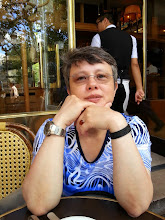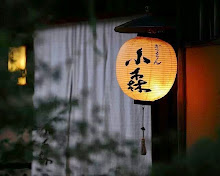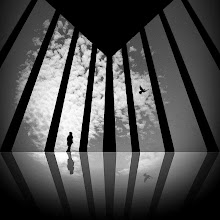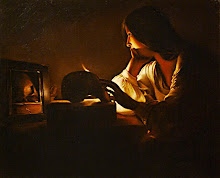"La table aux lanternes, Gerberoy", 1924, Henri Le Sidaner, Oil on Canvas, 126,4 x 148,6 cm, Owner Unknown
"It is l'heure de Le Sidaner, the time when he is most profoundly himself", wrote the art critic and Le Sidaner's close friend Camille Mauclair in his "Le Sidaner", Paris, 1928, p252. Le Sidaner's hour: that unique moment in the fleeting dusk, when all that is will soon cease to be present when the fragile link between visible and spiritual reality will appear to those attentive and silent enough to see it. "La table aux lanternes, Gerberoy", belongs to Henri Le Sidaner's Laid Table series, which started when the painter settled in the small medieval village of Gerberoy in 1901, near Beauvais in northern France. With its rather large format, "La table aux lanternes, Gerberoy", is an unusual compromise between a landscape and a still-life painting.
But the analogy goes even further. In a landscape painting, regardless of its dimensions, the onlooker's eye is somehow drawn into the picture by way of pictorial devices such as the perspective, the interplay of lines, colors, motifs, etc. In a still-life painting, there is always an element of more or less obvious aloofness. The onlooker is invited to contemplate the painting and to reflect on its meaning. Experiencing is then less important than grasping, which relates more to an intellectual relation to painting. In "La table aux lanternes, Gerberoy", both experiences occur. Yet appearances may be deceptive. Sometimes, a painting is not what it seems to be. Or is it?
With "La table aux lanternes, Gerberoy", we are both inside and outside the painting at the same time. Because of its format and its dreamy quality, one can easily be absorbed into the painting - as one would while wandering throughout a beautiful landscape - yet something keeps us at the threshold of the canvas, something that 'speaks' to us and expects more from us than mere delight. More? When Le Sidaner settled in Gerberoy, he wanted to create a perfect garden in which he would be able to achieve the best light effects he sought for his painting. To him, Gerberoy represented the ideal settling where he would experiment with light and colors, but most of all with the passing nature of life. The fact that Claude Monet invited the painter to visit him at Giverny, in June 1918, must have contributed greatly to his desire to search for his own quality of light and time.
Time? I could not but believe that it was time first that mattered to Le Sidaner. Although very close to Impressionism, especially with its obsession of fleetingness, Le Sidaner remained a Symbolist painter at heart. He had the Impressionist fragmented brushstroke and the eye for capturing the fluidity of light, but he was not just an eye. One only needs to look at "La table aux lanternes, Gerberoy", to realize what this painting is all about. The laid table: the guests absent, a woman left her shawl on the back of a chair. It has been a warm summer evening, but now it is beginning to get a bit chilly. The warm hues cast by the Oriental lanterns no longer suffice. Perhaps, the hostess suggested having the liqueur inside the house? How quickly the temperature has dropped. How quickly everything changes. How unique and fragile the moment is.
It is not difficult to believe that "La table aux lanternes, Gerberoy", was Le Sidaner's favorite painting. Through it, the painter achieved what mattered to him most. It has the elegiac atmosphere the Symbolist artists strove for - Le Sidaner has been called in his time, the Georges Rodenbach of painting* - it also has the mysterious and contemplative feel that echoes the hidden correspondences between the settings and the inner mood. It is as if everything was on the verge of disappearing. Here, yet already gone. Time...
"But when from a long-distant past nothing subsists, after the people are dead, after the things are broken and scattered, taste and smell alone, more fragile but more enduring, more unsubstantial, more persistent, more faithful, remain poised a long time, like souls, remembering, waiting, hoping, amid the ruins of all the rest; and bear unflinchingly, in the tiny and almost impalpable drop of their essence, the vast structure of recollection". ("Remembrance of Things Past", Marcel Proust, Vol. 1, "Swann's Way", p48-51).
Sometimes a painting is really what it seems to be. A celebration, the painter's way of celebrating life in all its beauty and frailty. Can you hear in the distance the nice piece of piano music? Can you hear the silence? The poetry of reaching one's heart through the sorrow of the goodbyes? Can you see what is not painted? Will you remember this perfect summer evening, even after you are gone? Was it real or was it merely a dream? Or was our world simply hovering between dusk and night? Regarde, le soir dépose un à un les ors du songe. Hâte toi d'aimer. La vie: un rêve? Le moment venu, l'illusion d'avoir vécu nous fermera les yeux.
* "Bruges-la-morte", by Georges Rodenbach, Editions Flammarion, Paris, 1892













